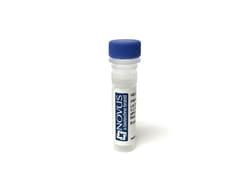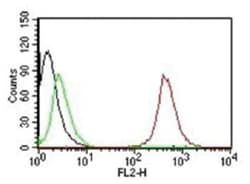CD53 Antibody (161-2) - Azide and BSA Free, Novus Biologicals™
Mouse Monoclonal Antibody
Manufacturer: Fischer Scientific
The price for this product is unavailable. Please request a quote
Antigen
CD53
Concentration
1.0 mg/mL
Applications
Flow Cytometry, Immunofluorescence, CyTOF
Conjugate
Unconjugated
Host Species
Mouse
Research Discipline
Immunology
Formulation
PBS with No Preservative
Gene ID (Entrez)
963
Immunogen
Stimulated human leukocytes
Primary or Secondary
Primary
Content And Storage
Store at 4C short term. Aliquot and store at -20C long term. Avoid freeze-thaw cycles.
Clone
161-2
Dilution
Flow Cytometry : 0.5 - 1 ug/million cells in 0.1 ml, Immunofluorescence : 0.5 - 1.0 ug/ml, CyTOF-ready
Classification
Monoclonal
Form
Purified
Regulatory Status
RUO
Target Species
Human, Baboon (Negative), Equine (Negative)
Gene Alias
antigen MOX44 identified by monoclonal MRC-OX44, CD53 antigentetraspanin-25, CD53 glycoprotein, CD53 molecule, CD53 tetraspan antigen, cell surface antigen, Cell surface glycoprotein CD53, MOX44transmembrane glycoprotein, Tetraspanin-25, tspan-25, TSPAN25leukocyte surface antigen CD53
Gene Symbols
CD53
Isotype
IgG2a κ
Purification Method
Protein A or G purified
Test Specificity
Recognizes a protein of 33-55kDa, identified as CD53 (Workshop VI; Code N-L033). It is expressed on monocytes and macrophages, dendritic cells, osteoblasts and osteoclasts, and on T and B cells from every stage of differentiation but is absent from platelets, red blood cells. CD53 appears to be the marker with widest reactivity as well as the marker with the strictest specificity to hematopoietic cells. CD53 is a type III membrane with both termini in the cytoplasm and two loops in the extracellular environment. This molecule, in common with other members of tetraspan family, is involved in cellular activation as part of a signal transduction complex involving other membrane glycoproteins. CD53 crosslinking induces calcium flux on human monocyte and B cells. Cross-linking of CD53 promotes activation of resting human B-lymphocytes. This MAb recognizes CD53 transfected cells and partially inhibits T-cell proliferation induced by CD3 antibody (clone: UCHT1).
Description
- CD53 Monoclonal specifically detects CD53 in Human, Baboon (Negative), Equine (Negative) samples
- It is validated for Flow Cytometry, Immunocytochemistry/Immunofluorescence, Functional, Immunofluorescence, CyTOF-ready.

